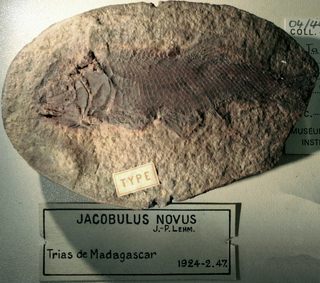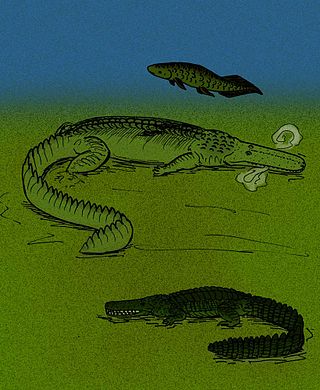Fleurantia is a genus of prehistoric lungfish which lived during the Devonian period. Fossils have been found in North America.
Ferganoceratodus is a genus of prehistoric lungfish known from the Mesozoic of Asia and Africa. Based on morphological evidence, it has either been recovered as a basal member of the Ceratodontiformes or to be the sister group of the Neoceratodontidae.
Ganorhynchus is an extinct genus of prehistoric lungfish from the Devonian period. Fossils were found in Mansfield, Pennsylvania.

Jacobulus is an extinct genus of prehistoric ray-finned fish that lived during the Early Triassic epoch in what is now northern Madagascar 252.3 to 251.3 million years ago. The type species is Jacobulus novus (monotypy). It was a small fish less than 10 centimetres (3.9 in) in length. J. novus ecology was a grazer-detritivore. It belongs to the Parasemionotidae together with Albertonia, Candelarialepis, Icarealcyon, Lehmanotus, Parasemionotus, Qingshania, Stensioenotus, Suius, Thomasinotus, and Watsonulus.
Gosfordia is an extinct genus of prehistoric lungfish known from the Triassic of Australia.
Devonosteus is an extinct genus of prehistoric marine lobe-finned fish known from the Late Devonian. It contains a single species, D. proteus from the late Frasnian of Wildungen, Germany. It has sometimes been considered a lungfish of the family Holodontidae, but this remains uncertain as the original specimen may be lost. Alternatively, it may be a tristichopterid, a type of basal tetrapodomorph.
Lochmocercus is an extinct genus of prehistoric coelacanth fishes which lived during the Carboniferous Period.
Hainbergia is an extinct genus of prehistoric sarcopterygian or lobe-finned fish.
Osteoplax is an extinct genus of prehistoric sarcopterygians or lobe-finned fish.
Oervigia is an extinct genus of lungfish in the family Rhinodipteridae from the Devonian of Greenland.
Mioceratodus is an extinct genus of lungfish in the family Neoceratodontidae, which also contains the extant Queensland lungfish. It is known only from Oligocene and Miocene-aged sediments in Australia, although phylogenetic evidence supports it having first diverged from its closest relative, Neoceratodus, during the Late Jurassic or Early Cretaceous period.
Metaceratodus is an extinct genus of prehistoric lungfish in the family Ceratodontidae, with an indeterminate specimen known from the Late Triassic (Norian)-aged Lissauer Breccia of Poland and more complete specimens known from the Late Cretaceous of Queensland, Australia and Argentina. The genus was named and described by Frederick Chapman in 1914.

Megapleuron is an extinct genus of prehistoric sarcopterygian or lobe-finned fish that lived during the Asselian age of the Cisuralian epoch in what is now Burgundy, France.
Sagenodus is an extinct genus of prehistoric lungfish. It is a lungfish from the Permo-Carboniferous period found in Europe and North America.
Rhinodipterus is an extinct genus of prehistoric dipnoan sarcopterygians or lobe-finned fish, that lived in the Devonian Period, between 416 and 359 million years ago. It is believed to have inhabited shallow, salt-water reefs, and is one of the earliest known examples of marine lungfish. Research based on an exceptionally well-preserved specimen from the Gogo Formation of Australia has shown that Rhinodipterus has cranial ribs attached to its braincase and was probably adapted for air-breathing to some degree as living lungfish are. This could be the only case known for a marine lungfish with air-breathing adaptations.

Retodus is an extinct genus of prehistoric lungfish found in Cretaceous-aged freshwater strata of Egypt, Algeria and Niger. The type species, R. tuberculatus, was named in 2006. It was originally named as a species of Ceratodus and Neoceratodus in 1963.

Paraceratodus is an extinct genus of prehistoric lungfish. Only one species, P. germaini, is known from the latest Permian or earliest Triassic period of Madagascar. Phylogenetic evidence supports it being the most basal member of the suborder Ceratodontoidei, which contains modern lungfish, and as with the rest of the order it likely diverged during the late Carboniferous.
Orlovichthys is an extinct genus of prehistoric sarcopterygians or lobe-finned fish. Fossil evidence was found in Russia, and is from the Late Devonian period.
Tarachomylax is an extinct genus of prehistoric sarcopterygians or lobe-finned fish.

Ceratodontiformes is the only extant order of lungfish, containing the families Neoceratodontidae, Lepidosirenidae, and Protopteridae as well as many other extinct groups. Members of this group are the only lungfish known to have survived the Permian-Triassic extinction event. Although lungfish originated in marine environments, the Ceratodontiformes have been an exclusively freshwater group since the Carboniferous. This order was formerly considered the suborder Ceratodontoidei.









